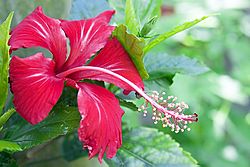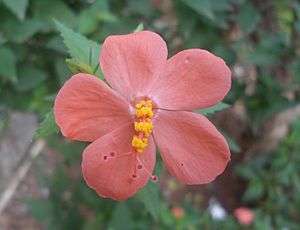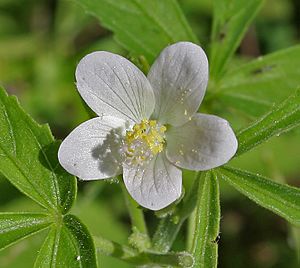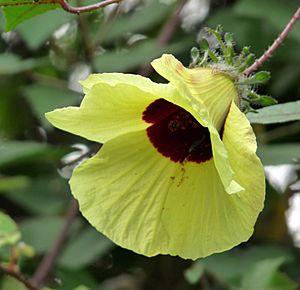Hibiscus facts for kids
Quick facts for kids Hibiscus |
|
|---|---|
 |
|
| A red hibiscus flower in Sydney, Australia during late Spring | |
| Scientific classification | |
| Kingdom: | |
| Division: | |
| Class: | |
| Order: | |
| Family: | |
| Genus: |
Hibiscus
|
Hibiscus or rosemallow is a genus of plants known for their bright, colorful flowers. These beautiful plants mostly grow in warm, tropical places. However, some types can also grow in cooler areas.
Many countries and states have chosen the hibiscus as their special flower. For example, the yellow hibiscus is the state flower of Hawaii. Hibiscus flowers usually have five petals. They come in many colors, such as white, pink, red, purple, orange, and yellow.
Contents
What Does a Hibiscus Look Like?
The leaves of the hibiscus plant grow in an alternating pattern. They can be oval-shaped or oval at one end and pointy at the other. Their edges are usually jagged or smooth.
The flowers are big and showy. They are shaped like a trumpet and have five or more petals. These flowers can be white, pink, red, orange, peach, yellow, or purple. They can be quite large, from about 1.6 to 7 inches (4 to 18 cm) wide.
After the flower blooms, it produces a dry, five-part capsule. This capsule holds several seeds in each part. When the capsule is ready, it splits open to release the seeds.
Hibiscus Flower's Life Cycle
How People Use Hibiscus

Hibiscus in Culture and Symbols
The hibiscus is an important symbol in many places around the world. It is a national symbol of Haiti. It is also the national flower of the Solomon Islands and Niue.
Hibiscus syriacus is the national flower of South Korea. The Hibiscus rosa-sinensis is the national flower of Puerto Rico and Malaysia.
In Hinduism, the red hibiscus is special to the goddess Kali. Art from Bengal, India, often shows Kali and the flower together. People offer hibiscus flowers to the goddess Kali and Lord Ganesha during worship.
In the Philippines, children use the gumamela (local name for hibiscus) to make bubbles. They crush the flowers and leaves to get sticky juice. Then, they dip hollow papaya stalks into the juice and blow bubbles. Adding soap to the juice makes even more bubbles!
The hibiscus is Hawaii's state flower. In both Tahiti and Hawaii, girls wear hibiscus flowers behind their ears. This shows if they are in a relationship or not. A flower behind the left ear means she is married or has a partner. A flower behind the right ear means she is single.
Hibiscus in Industry
The bark of the hibiscus plant has strong fibers called bast fibers. These fibers come from the stem. To get them, the bark is stripped and left in the sea. This helps the other plant material rot away.
These strong fibers can be spun together to make thread, string, or rope. They can also be woven into fabric or used in other materials.
One type of Hibiscus, called kenaf (Hibiscus cannabinus), is used to make paper.
Growing Hibiscus in Gardens
Many types of hibiscus are grown because of their beautiful flowers. They are often used as landscape shrubs. These plants also help attract butterflies, bees, and hummingbirds to gardens.
Hibiscus is a tough and adaptable plant. In tropical areas, it can make any garden look more beautiful. It can grow well in small spaces, like balcony gardens in cities. You can easily grow it in pots or even in hanging baskets. Some types of hibiscus flower all year long.
Gardeners should watch out for tiny insects called mealybugs. You can spot them by their white, cotton-like patches on buds, leaves, or stems. To protect the plant, you can trim off the infected parts. Then, spray the plant with water and use a suitable pesticide.
Hibiscus as a Drink
Tea made from hibiscus flowers is popular around the world. It is served both hot and cold. This drink is known for its bright red color, tangy taste, and unique flavor. Hibiscus tea is also healthy because it contains vitamin C.
Hibiscus as Food
Dried hibiscus flowers are edible. They are often a special treat in Mexico. You can also candy them and use them to decorate desserts.
The roselle (Hibiscus sabdariffa) is a type of hibiscus used as a vegetable. The species Hibiscus suratensis is used to add a sour taste to food and as an ingredient in chicken soup.
Some insects, like the nutmeg moth and the turnip moth, eat Hibiscus plants when they are in their larvae (caterpillar) stage.
Traditional Uses of Hibiscus
In Indian Ayurveda, a traditional medicine system, Hibiscus rosa-sinensis is described as having several uses.
Popular Types of Hibiscus
Here are some of the most popular types of Hibiscus grown in gardens:
- Hibiscus brackenridgei (Hawaiian hibiscus)
- Hibiscus rosa-sinensis (Chinese hibiscus)
- Hibiscus syriacus (garden hibiscus)
Hibiscus trionum is a common plant that can sometimes grow like a weed in gardens and on farms.
Fun Facts About Hibiscus
- There are over 200 different types, or species, of hibiscus plants in the world.
- Some hibiscus plants live for only one year (called annuals). Others live for many years (called perennials).
- A hibiscus can grow as a small plant, a woody shrub, or even a small tree.
- You can rub hibiscus flowers on leather shoes to make them shiny again.
- The flower can be used to make natural dyes or food coloring.
- The leaves and flowers of a hibiscus plant can be made into a nice-smelling shampoo.
- The yellow hibiscus, which is Hawaii's state flower, is an endangered plant.
Images for kids
-
The yellow hibiscus is the state flower of Hawaii, though Hibiscus rosa-sinensis is more commonly seen there.
See also
 In Spanish: Hibiscus para niños
In Spanish: Hibiscus para niños











